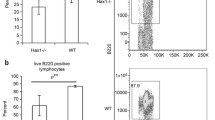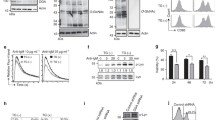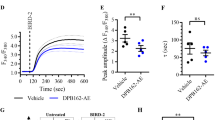Abstract
The activity of Bad, a pro-apoptotic protein, is regulated by reversible phosphorylation. Moreover, sequestration of Bad within subcellular compartments may be a new mechanism of apoptosis regulation. In this study, we report that Bad interacts with 14-3-3 protein in WEHI-231 immature B cells. This association is disrupted following BCR stimulation in correlation with Bad translocation to mitochondria and apoptosis. Confocal microscopy was further used to examine the co-localization of Bad with lipid rafts in WEHI-231 and murineex vivoB cells. Bad was found colocalized to lipid rafts in freshly isolated mature B lymphocytes, in contrast to immature cells. Finally, co-immunoprecipitation experiments performed on WEHI-231 B cells revealed that PP1α interacts with Bcl-2 and Bad, and dissociation of the complex was found correlated with appearance of apoptosis. Bcl-2 seemed to be required to assemble the complex which may regulate Bad phosphorylation status and consequently cell survival. Collectively, present data outline the role of Bad trafficking in the BCR-mediated apoptosis and suggest that differences in intracellular Bad trafficking may be involved in the differential outcome of BCR signaling.
Similar content being viewed by others
References
Nossal GJV. Negative selection of lymphocytes. Cell 1994;76: 229–239.
Green DR, Scott DW. Activation-induced apoptosis in lymphocytes. Curr Opin Immunol 1994; 6: 476–487.
Niiro H, Clark EA. Regulation of B-cell fate by antigen-receptor signals. Nat Rev Immunol 2002; 2: 945–956.
Ruvolo PP, Deng X, May WS. Phosphorylation of Bcl2 and regulation of apoptosis. Leukemia 2001; 15: 515–522.
Fleischer A, Rebollo A, Ayllon V. BH3-only proteins: The lords of death. Arch. Immunol Ther Exp (Warsz) 2003; 51: 9–17.
Zha J, Harada H, Yang E, Jockel J, Korsmeyer SJ. Serine phosphorylation of death agonist BAD in response to survival factor results in binding to 14.3.3 not Bcl-X(L). Cell 1996; 87: 619–628.
Bae J, Hsu SY, Leo CP, Zell K, Hsueh AJ. Underphosphorylated BAD interacts with diverse antiapoptotic Bcl-2 family proteins to regulate apoptosis. Apoptosis 2001; 6: 319–330.
Datta SR, Ranger AM Lin, et al. Survival factor-mediated Bad phosphorylation raises the mitochondrial threshold for apoptosis. Dev Cell 2002; 3: 631–643.
Puthalakath H, Strasser A. Keeping killers on a tight leash: Transcriptional and post-translational control of the pro-apoptotic activity of BH3-only proteins. Cell Death Differ 2002; 9: 505–512.
Schinzel A, Kaufmann T, Borner C. Bcl-2 family members: Integrators of survival and death signals in physiology and pathology [corrected]. Biochim Biophys Acta 2004; 1644: 95–105. Erratum in: Biochim Biophys Acta 1692: 45.
Hinton HJ, Welham MJ. Cytokine-induced protein kinase B activation and Bad phosphorylation do not correlate with cell survival of hemopoietic cells. J Immunol 1999; 162: 7002–7009.
Chiang CW, Harris G, Ellig, et al. Protein phosphatase 2A activates the proapoptotic function of BAD in interleukin- 3-dependent lymphoid cells by a mechanism requiring 14-3-3 dissociation. Blood 2001; 97: 1289–1297.
Zhao S, Konopleva M, Cabreira-Hansen, et al. Inhibition of phosphatidylinositol 3-kinase dephosphorylates BAD and promotes apoptosis in myeloid leukemias. Leukemia 2004; 18: 267–275.
Cheng PC, Brown BK, Song W, Pierce SK. Translocation of the BCR into lipid rafts reveals a novel step in signaling. J Immunol 2001; 166: 3693–3701.
Pierce SK. Lipid rafts and B-cell activation. Nat Rev Immunol 2001; 2: 96–105.
Sproul TW, Malapati S, Kim J, Pierce SK. Cutting edge: B cell antigen receptor signaling occurs outside lipid rafts in immature B cells. J Immunol 2000; 165: 6020–6023.
Fleischer A, Ghadiri A, Dessauge, et al. Bad-dependent rafts alteration is a consequence of an early intracellular signal triggered by interleukin-4 deprivation. Mol Cancer Res 2004; 2: 674–684.
Ayllon V, Fleischer A, Cayla X, Garcia A, Rebollo A. Segregation of Bad from lipid rafts is implicated in the induction of apoptosis. J Immunol 2002; 168: 3387–3393.
Benhamou LE, Cazenave P, Sarthou P. Anti-immunoglobulins induce death by apoptosis in WEHI-231 B lymphoma cells. Eur J Immunol 1990; 20: 1405–1407.
Hasbold J, Klaus GG. Anti-immunoglobulin antibodies induce apoptosis in immature B cell lymphomas. Eur J Immunol 1990; 20: 1685–1690.
Scott DW. Analysis of B cell tolerancein vitro.Adv Immunol 1993; 54: 393–425.
Gottschalk AR, Quintans J. Apoptosis in B lymphocytes: The WEHI-231 perspective. Immunol.Cell Biol 1995; 73: 8–16.
Malissein E, Verdier M, Ratinaud MH, Troutaud D. Changes in Bad phosphorylation are correlated with BCR-induced apoptosis in WEHI-231 immature B cells. Biochimie 2003; 85: 733–740.
Rottenberg H, Wu S. Quantitative assay by flow cytometry of the mitochondrial membrane potential in intact cells. Biochim Biophys Acta 1998; 1404: 393–404.
Harder T, Scheiffele P, Verkade P, Simons K. Lipid domain structure of the plasma membrane revealed by patching of membrane components. J Cell Biol 1998; 141: 929–942.
Ayllon V, Cayla X, Garcia, et al. Bcl-2 targets protein phosphatase 1 alpha to Bad. J Immunol 2001; 166: 7345–7352.
Ezhevsky SA, Toyoshima H, Hunter T, Scott DW. Role of cyclin A and p27 in anti-IgM induced G1 growth arrest of murine B-cell lymphomas. Mol Biol Cell 1996; 17: 553–564.
Klaus GG, Choi MS, Lam EW, Johnson-Leger C, Cliff J. CD40: A pivotal receptor in the determination of life/death decisions in B lymphocytes. Int Rev Immunol 1997; 15: 5–31.
Donjerkovic D, Zhang L, Scott DW. Regulation of p27Kip1 accumulation in murine B-lymphoma cells: Role of c-Myc and calcium. Cell Growth Differ 1999; 10: 695–704.
Banerji L, Glassford J, Lea, et al. BCR signals target p27(kip1) and cyclin D2 via the PI3K signalling pathway to mediate cell cycle arrest and apoptosis of WEHI 231 B cells. Oncogene 2001; 20: 7352–7367.
Enders A, Bouillet P, Puthalakath H, Xu Y, Tarlinton DM, Strasser A. Loss of the pro-apoptotic BH3-only Bcl-2 family member Bim inhibits BCR stimulation-induced apoptosis and deletion of autoreative B cells. J Exp Med 2003; 198: 1119–1126.
Strasser A. The role of BH3-only proteins in the immune system. Nat Rev Immunol 2005; 5: 189–200.
Ranger AM, Zha J, Harada, et al. Bad-deficient mice develop diffuse large B cell lymphoma. Proc Natl Acad Sci USA 2003; 100: 9324–9329.
Datta SR, Katsov A, Hu, et al. 14.3.3 proteins and survival kinases cooperate to inactivate BAD by BH3 domain phosphorylation. Mol Cell 2000; 6: 41–51.
Muscarella DE, Bloom SE. Cross-linking of surface IgM in the Burkitt’s lymphoma cell line ST486 cells provides protection against arsenite- and stress- apoptosis that is mediated by ERK and phosphoinositide 3-kinase signaling pathways. J Biol Chem 2003; 278: 4358–4367.
Malissein E, Verdier M, Ratinaud MH, Troutaud D. Bcl-2 protein phosphorylation /dephosphorylation and apoptosis induced by B cell antigen receptor ligation (review). In: Pandalai SG, ed. Trivandrum: Research signpost. Recent research developments in Immunology. 2003: 669–683.
Foster LJ, De Hoog CL, Mann M. Unbiased quantitative proteomics of lipid rafts reveal high specificity for signaling factors. Proc Natl Acad Sci USA 2003; Trivandrum: Research signpost100 : 2813–2818.
Garcia A, Cayla X, Fleischer A, et al. Rafts: A simple way to control apoptosis by subcellular redistribution. Biochimie 2003; 85: 727–731.
Muppidi JR, Tschopp J, Siegel RM. Life and death decisions: Secondary complexes and lipid rafts in TNF receptor family signal transduction. Immunity 2004; 21:461–465.
Fais S, De Milito A, Lozupone F. The role of FAS to ezrin association in FAS-mediated apoptosis. Apoptosis 2005; 10:941–947.
Ayllon V, Martinez-A C, Garcia A, Cayla X, Rebollo A. Protein phosphatase 1 alpha is a Ras-activated Bad phosphatase that regulates interleukin-2 deprivation-induced apoptosis. EMBO J 2000; 19: 2237–2246.
Bouillet P, Strasser A. BH3-only proteins - evolutionarily conserved proapoptotic Bcl-2 family members essential for initiating programmed cell death. J Cell Sci 2002; 115: 1567–1574.
Hubbard MJ, Cohen P. On target with a new mechanism for the regulation of protein phosphorylation. Trends Biochem Sci 1993; 18: 172–177.
Faux MC, Scott JD. More on target with protein phosphorylation: Conferring specificity by location. Trends Biochem Sci 1996; 21: 312–315.
Garcia A, Cayla X, Guergnon, et al. Serine/threonine protein phosphatases PP1 and PP2A are key players in apoptosis. Biochimie 2003; 85: 721–726.
Garcia A, Cayla X, Caudron, et al. New insights in protein phosphorylation: A signature for protein phosphatase 1 interacting proteins. C R Biol 2004; 327: 93–97.
Chang BS, Minn AJ, Muchmore SW, Fesik SW, Thompson CB. Identification of a novel regulatory domain in Bcl-XL and Bcl-2. EMBO J 1997; 16: 968–977.
Ayllon V, Cayla X, Garcia A, Fleischer A, Rebollo A. The anti-apoptotic molecules Bcl-xL and Bcl-w target protein phosphatase 1α to Bad. Eur J Immunol 2002; 32: 1847–1855.
Author information
Authors and Affiliations
Corresponding author
Rights and permissions
About this article
Cite this article
Malissein, E., Verdier, M., Ratinaud, M.H. et al. Activation of Bad trafficking is involved in the BCR-mediated apoptosis of immature B cells. Apoptosis 11, 1003–1012 (2006). https://doi.org/10.1007/s10495-006-6713-7
Published:
Issue Date:
DOI: https://doi.org/10.1007/s10495-006-6713-7




